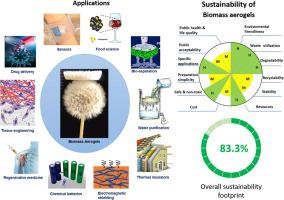Progress in Materials Science ( IF 33.6 ) Pub Date : 2021-12-25 , DOI: 10.1016/j.pmatsci.2021.100915 Gang Wei 1 , Jianming Zhang 2 , Mattia Usuelli 3 , Xiaofang Zhang 2 , Bin Liu 1 , Raffaele Mezzenga 3, 4

|
The highly efficient utilization of bioresources and natural organic wastes has attracted great attention, due to the high-speed consumption and shortage of energy in modern society. Aerogels, attributable to their outstanding properties and potential applications in diverse fields, have been a major topic of innovative materials research in the last decades. While previously the scientific community has mainly focused on inorganic- and plastic-based aerogels, recent years have witnessed a growing interest in their biomass-based counterparts. In fact, numerous studies on the fabrication, modification, and applications of cellulose, polysaccharide, protein, peptide, and other bio-derived aerogels have been widely reported. In this review, we focus on recent advances in the biomass-based aerogels field. The analysis that we perform ranges from their structural design to routes for functional tailoring, and encompasses resource-efficient applications; the aim is to provide a comprehensive review based on a robust analysis of available data. The fabrication techniques, structure and properties of biomass-based aerogels are introduced, together with their chemical, mechanical, electrical, optical, and biological properties. In addition, the structural design, functional tailoring, and applications of biomass-based aerogels are demonstrated. Furthermore, we enrich the actual literature state-of-the-art with a broad sustainability analysis, that compares biomass-based aerogels to the most studied inorganic/plastic-based counterparts. To this end, we perform a comparison with inorganic- and plastic-based aerogels by sustainability footprint analysis, which accounts for 12 sustainability parameters on environmental, social, and techno-economic impacts. This review will guide readers in understanding the fabrication of biomass-based aerogels, together with their structural and functional adjustment, through comprehensively presenting the state-of-the-art on their sustainable applications in fields as diverse as biomedical engineering, energy materials, nanodevices, chemical engineering, and environmental science.
中文翻译:

生物质气凝胶与无机和塑料气凝胶:结构设计、功能定制、资源节约型应用和可持续性分析
由于现代社会能源的高速消耗和短缺,生物资源和天然有机废弃物的高效利用引起了人们的极大关注。气凝胶由于其优异的性能和在不同领域的潜在应用,在过去的几十年中一直是创新材料研究的主要课题。虽然以前科学界主要关注基于无机和塑料的气凝胶,但近年来人们对基于生物质的气凝胶的兴趣日益浓厚。事实上,关于纤维素、多糖、蛋白质、肽和其他生物衍生气凝胶的制造、改性和应用的大量研究已被广泛报道。在这篇综述中,我们关注基于生物质的气凝胶领域的最新进展。我们执行的分析范围从结构设计到功能剪裁路线,包括资源高效应用;其目的是在对现有数据进行有力分析的基础上进行全面审查。介绍了基于生物质的气凝胶的制造技术、结构和性能,以及它们的化学、机械、电学、光学和生物学特性。此外,还展示了基于生物质的气凝胶的结构设计、功能定制和应用。此外,我们通过广泛的可持续性分析丰富了实际文献的最新技术,将生物质基气凝胶与研究最多的无机/塑料基气凝胶进行了比较。为此,我们通过可持续性足迹分析与无机和塑料基气凝胶进行了比较,其中包含 12 个关于环境、社会和技术经济影响的可持续性参数。本综述将通过全面介绍其在生物医学工程、能源材料、纳米器件等不同领域可持续应用的最新进展,引导读者了解基于生物质的气凝胶的制备及其结构和功能调整。 、化学工程和环境科学。











































 京公网安备 11010802027423号
京公网安备 11010802027423号